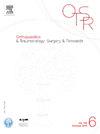根据代表性小组估算的法国整形外科手术废弃物平均总重量和二氧化碳碳足迹。
IF 2.3
3区 医学
Q2 ORTHOPEDICS
引用次数: 0
摘要
背景:减少废物和碳足迹可以实现最优化。对碳源的认识和废物的量化是两个关键参数。据我们所知,法国还没有一项关于骨科手术团队在手术过程中产生的废物的全球性研究。因此,我们进行了一项观察性调查,旨在1)量化和描述骨科手术后产生的废物重量,2)计算这些废物产生的二氧化碳足迹,并推断出全国范围内的数字:假设:不同手术类型产生的废物差异很大,感染性临床废物仍是废物和二氧化碳排放的主要来源:这是一项前瞻性比较研究,共选择了 14 种具有代表性的手术:关节置换术(髋关节、膝关节)、脊柱融合术、关节镜手术(肩关节、膝关节)、神经松解术、前足截骨术、创伤手术。主要结果是 14 类废物的平均总重量(280 次测量:140 乘以 2,每次手术结束时),单位为公斤(kg),以及感染性临床废物(ICW)和家庭废物(HW)的比例,单位为百分比。2022 年 1 月至 9 月期间,对一家教学医院的每种手术进行了十项前瞻性记录。废物处理过程中产生的理论碳足迹以千克二氧化碳当量(KgEqCO2)为单位进行估算。利用 VisuChir 工具收集了 2021 年法国的手术总数,从而推算出全国的碳足迹:结果:140 项手术共产生了 937 千克废物,其中 514 千克 ICW(54.8%)和 423 千克 HW(45.2%)。废物重量的总体中位数为 5.9 千克(Q1:4.4, Q3:8.1),从 1.8 千克到 18.3 千克不等。卫生废物的总体重量中位数为 2.8 千克(第一季度:2.5 千克,第三季度:3.4 千克),介于 1.8 千克至 17.8 千克之间。ICW 废物重量的总体中位数为 3.8 千克(第一季度:2.7 千克,第三季度:4.8 千克),从 0.8 千克到 7.2 千克不等。膝关节手术造成的废物重量最大;产生废物最少的手术是足部手术和腕管松解术。ICW的中位比例从全膝关节置换术的39%到股骨钉的72%不等。废物总重量与ICW比例之间存在明显的反相关关系:r=-0.47,p结论:我们的研究表明,在大多数情况下,半数以上的废物都是ICW。据估计,骨科手术的全国碳足迹总量为 1000 万公斤。减少 ICW 是减少碳排放的基石,因为 ICW 造成了更多的碳排放:证据等级:III ;前瞻性比较观察活体研究。本文章由计算机程序翻译,如有差异,请以英文原文为准。
Average total weight of surgical waste and CO2 carbon footprint of orthopedic surgery in France, estimated on the basis of a representative panel
Background
Reduction of waste and carbon footprint can be optimized. Awareness of carbon sources and quantification of the waste are two key parameters. To our knowledge, there is no study in France on waste production by the surgical team during the operation in orthopedic surgery, in a global scope. Therefore, we performed an observational investigation aiming to: (1) quantify and characterize the weight of the wastes generated after a panel of orthopedic procedures, (2) calculate the CO2 footprint generated by these wastes and extrapolate the figure at the national scale.
Hypothesis
Waste production is highly variable according to the types of procedures and infectious clinical waste is still a predominant source of waste and CO2 emission.
Materials and methods
It is a comparative and prospective study in which a total of 14 procedures were selected as a representative panel: arthroplasties (hip, knee), spine fusions, arthroscopic procedures (shoulder, knee), nerve release, forefoot osteotomies, trauma procedures. The main outcome was the average total weight of waste for each of the fourteen categories (280 measurements: 140 times 2, at the end of each procedure), expressed in kilograms (kg), and the proportions of infectious clinical waste (ICW) and household wastes (HW), expressed in percentages. Ten measures were prospectively recorded for each type of procedure in a single teaching hospital from January to September 2022. The theoretical carbon footprint generated by the treatment of the wastes was estimated in kilograms of CO2 equivalent (KgEqCO2). The national extrapolation of the carbon footprint was performed by collecting the total number of procedures in France in 2021 using the VisuChir tool.
Results
A total of 937 kg of waste were produced for the 140 procedures, amongst which 514 kg of ICW (54.8%) and 423 kg of HW (45.2%). The overall median waste weight was 5.9 kg (Q1: 4.4, Q3: 8.1), ranging from 1.8 kg to 18.3 kg. The overall median waste weight for HW was 2.8 kg (Q1: 2.5, Q3: 3.4), ranging from 1.8 kg to 17.8 kg. The overall median waste weight for ICW was 3.8 kg (Q1: 2.7, Q3: 4.8), ranging from 0.8 kg to 7.2 kg. The knee surgeries were responsible for the heaviest waste weight; the least waste-productive procedures were the foot and the carpal tunnel release. The median proportions of ICW varied from 39% for the total knee replacements to 72% for the femoral nails. There was a significant inverse correlation between the total waste weight and the proportion of ICW: r = −0.47, p < 10−4. The total median estimated carbon footprint was 4.3 KgCO2Eq (Q1: 3.1, Q3: 5.8), ranging from 1.59 KgCO2Eq (Q1: 1.5, Q3: 1.8) and 7.07 KgCO2Eq (Q1: 6.7, Q3: 8.17). The total median estimated carbon footprint was 3.5 KgCO2Eq for ICW (Q1: 2.5, Q3: 4.5) and 0.76 KgCO2Eq (Q1: 0.54, Q3: 1.3) for HW. The national median estimated carbon footprint was 10.1 million KgEqCO2 in 2021 for orthopedic surgery.
Conclusion
Our study revealed that in most cases more than half of the wastes were ICW. The total estimated national carbon footprint for orthopedic procedures was 10 million kilograms. The reduction of the ICW constitutes a cornerstone, as they are responsible for more carbon emissions.
Level of evidence
III; prospective comparative observational in vivo study.
求助全文
通过发布文献求助,成功后即可免费获取论文全文。
去求助
来源期刊
CiteScore
5.10
自引率
26.10%
发文量
329
审稿时长
12.5 weeks
期刊介绍:
Orthopaedics & Traumatology: Surgery & Research (OTSR) publishes original scientific work in English related to all domains of orthopaedics. Original articles, Reviews, Technical notes and Concise follow-up of a former OTSR study are published in English in electronic form only and indexed in the main international databases.

 求助内容:
求助内容: 应助结果提醒方式:
应助结果提醒方式:


